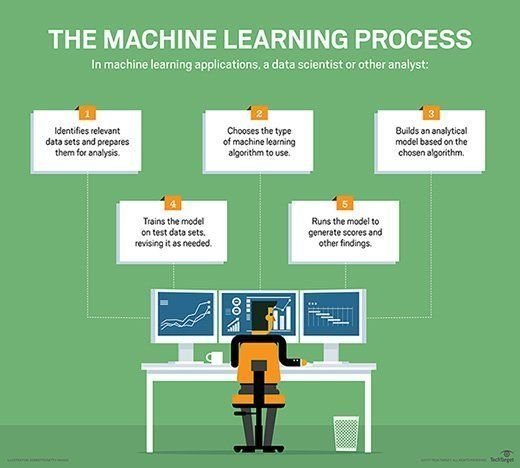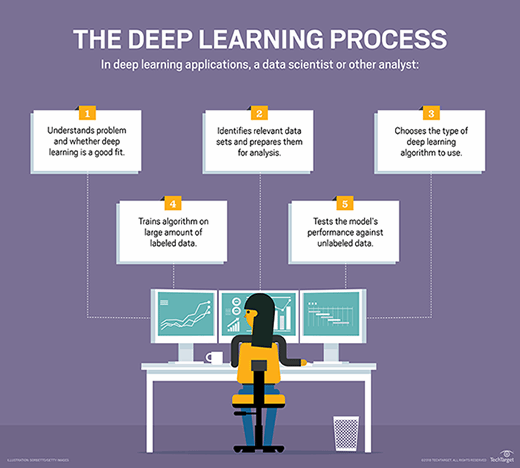What is Machine Learning?
Machine learning is the scientific study of algorithms and statistical models that computer systems use to effectively perform a specific task without using explicit instructions, relying on patterns and inference instead. It is seen as a subset of artificial intelligence.
- The machine in machine learning refers to an algorithm, or a method of computation. You could say that an algorithm combines math and logic.
- The learning in machine learning refers that the algorithm alters itself over time as it is exposed to data. That self-modification is called training.
The algorithm learns how to make better decisions based on that data, just as a human learn when they start making better decisions based on experience.

Fig 1: Overview of machine learning
Why use Machine Learning?
Finding patterns in data on planet earth is possible only for human brains. The data being very massive, the time taken to compute is increased, and this is where Machine Learning comes into action, to help people with large data in minimum time. If big data and cloud computing are gaining importance for their contributions, machine learning as technology helps analyse those big chunks of data, easing the task of data scientists in an automated process and gaining equal importance and recognition.
Types of Machine Learning Algorithms:
- Supervised Learning: Also called teacher based learning.
In supervised learning, the system tries to learn from the previous examples that are given. Speaking mathematically, supervised learning is where you have both input variables (x) and output variables(Y) and can use an algorithm to derive the mapping function from the input to the output.
The mapping function is expressed as Y = f(X).Supervised learning problems can be further divided into two parts, namely classification, and regression.
- Classification: A classification problem is when the output variable is a category or a group, such as “black” or “white” or “spam” and “no spam”.
- Regression: A regression problem is when the output variable is a real value, such as “Rupees” or “height.”
- Unsupervised Learning: It means no presence of a supervisor or teacher.
In unsupervised learning, the algorithms are left to themselves to discover interesting structures in the data. Mathematically, unsupervised learning is when you only have input data (X) and no corresponding output variables. This is called unsupervised learning because unlike supervised learning above, there are no given correct answers and the machine itself finds the answers. Supervised learning problems can be further divided into two parts:
- Association: An association rule learning problem is where you want to discover rules that describe large portions of your data, such as “people that buy X also tend to buy Y”.
- Clustering: A clustering problem is where you want to discover the inherent groupings in the data, such as grouping customers by purchasing behaviour.
- Reinforcement Learning
A computer program will interact with a dynamic environment in which it must perform a particular goal (such as playing a game with an opponent or driving a car). The program is provided feedback in terms of rewards and punishments as it navigates its problem space. The machine is exposed to an environment where it continuously trains itself using trial and error method.
Some Machine Learning Tools
- Python: a popular language with high-quality machine learning and data analysis libraries
- C++: a middle-level language used for parallel computing on CUDA
- R: a language for statistical computing and graphics
- Tensor Flow: flexible framework for large-scale machine learning
- Keras: lightweight, easy-to-use library for fast prototyping
- pandas: a Python data analysis library enhancing analytics and modelling.
- matplotlib: a Python machine learning library for quality visualizations
- scikit-learn: easy-to-use machine learning framework for numerous industries.
Today’s Scenario
The McKinsey Report states, “As ever more of the analog world gets digitized, our ability to learn from data by developing and testing algorithms will only become more important for what are now seen as traditional businesses.” It also quotes Google’s chief economist Hal Varian who calls this “computer kaizen” and adds, “just as mass production changed the way products were assembled, and continuous improvement changed how manufacturing was done… so continuous (and often automatic) experimentation will improve the way we optimize business processes in our organizations.” It’s clear that machine learning is here to stay.
Deep Learning : A Subset of ML
Deep Learning utilizes a hierarchical level of artificial neural networks to carry out the process of machine learning. The artificial neural networks are built like the human brain, with neuron nodes connected together like a web. While traditional programs build analysis with data in a linear way, the hierarchical function of deep learning systems enables machines to process data with a nonlinear approach.
We will be learning more about deep learning in our upcoming blogs on Deep Learning.

Fig:2 Overview of deep learning
…….Continues in second topic (from “Introduction to Deep Learning” to “Deep Neural Networks”)